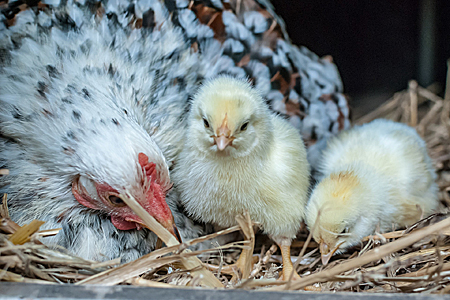
If a hen and her newly hatched chicks are left to wander around the poultry yard, the babies may fall prey to house cats, hawks, and other predators. And baby chicks can slip through most yard fences that are properly built to confine mature poultry. Chicks wandering around a yard can get chilled in damp grass or lost in tall vegetation. If a chick wanders far from its mother, she may not notice the little one is missing and fail to come to its rescue. Sometimes other birds in the flock will pick on the babies. Separately penning a hen with her chicks can help prevent such mishaps.
You might corral the hen and her brood in the corner of a garage, tool shed, or other outbuilding. Or you could set up a dedicated brooding pen, which is nothing more than a small shelter big enough for a hen and her growing chicks. You might, for instance, adapt a doghouse or an unused camper shell.
The brooding pen should be at least 3 feet by 3 feet for chickens, guineas, or ducks; 4 feet by 4 feet for turkeys or geese. The floor, walls, and roof must be constructed with no holes large enough for a weasel, rat, or snake to slip through.
Screened vents near the top will provide good airflow. A pop hole door opening onto a small run enclosed with hardware cloth will provide opportunities for exercise. Secure a tarp over the run to protect the hen and chicks from wet weather and hot sun.
For at least the first month, confine baby chicks and their mother hen to a separate pen, safe from the elements and predators.
Once the chicks begin to feather and become more independent, they will be ready to integrate into the home flock. Move the brooding pen inside the chicken yard, or at least adjacent to it, where the chicks will remain protected while they and the home flock become acquainted.
After a week, open the pen so the hen and chicks can wander into the main yard at their leisure. The hen will likely want to return to her old home, and the chicks will follow. The mother hen will deter possible harassment by flock mates that might not readily accept the chicks.
As with any major changes in the poultry yard, keep an eye on things in the event you might need to step in and re-confine the hen and chicks for a few days more. While the chicks are integrating into the flock, you will see a shift in the pecking order to accommodate the newcomers. That’s perfectly normal. Before long they’ll all be back to business as usual.
And that’s today’s news from the Cackle Coop.
Gail Damerow is the author of Hatching and Brooding Your Own Chicks.

